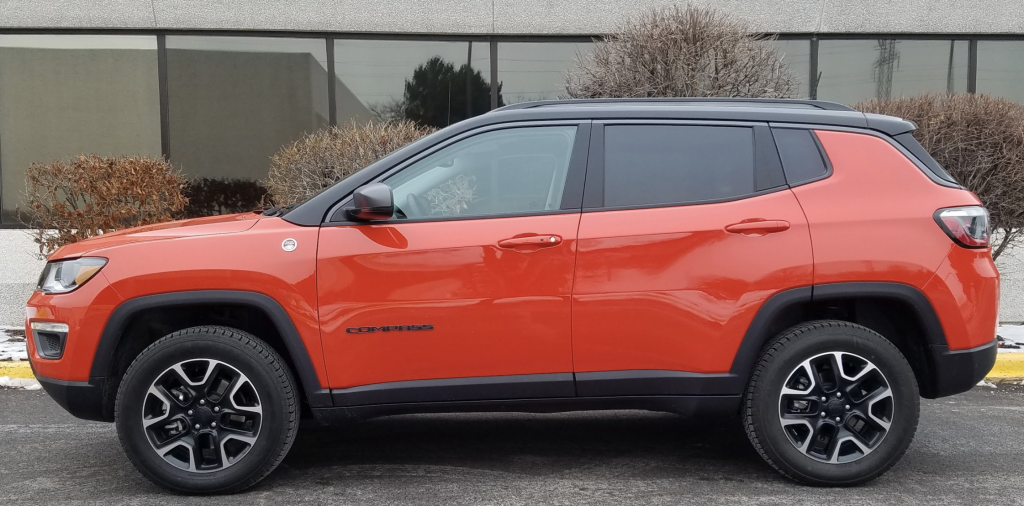
 2020 Jeep Compass Trailhawk
2020 Jeep Compass Trailhawk
Class: Compact Crossover SUV
Miles driven: 250
Fuel used: 12.4 gallons
| CG Report Card | |
|---|---|
| Room and Comfort | B+ |
| Power and Performance | C |
| Fit and Finish | B |
| Fuel Economy | C+ |
| Value | C |
| Report-card grades are derived from a consensus of test-driver evaluations. All grades are versus other vehicles in the same class. Value grade is for specific trim level evaluated, and may not reflect Consumer Guide's impressions of the entire model lineup. | |
| Big & Tall Comfort | |
| Big Guy | B |
| Tall Guy | B |
| Big & Tall comfort ratings are for front seats only. "Big" rating based on male tester weighing approximately 350 pounds, "Tall" rating based on 6'6"-tall male tester. | |
| Drivetrain | |
| Engine Specs | 180-hp 2.4-liter |
| Engine Type | 4-cylinder |
| Transmission | 9-speed automatic |
| Drive Wheels | 4WD |
Real-world fuel economy: 20.2
Driving mix: 50% city, 50% highway
EPA-estimated fuel economy: 22/30/25 (city, highway, combined)
Fuel type: Regular gas
Base price: $29,675 (not including $1495 destination charge)
Options on test vehicle: Premium Lighting Group ($695), Luxury Seat Group ($595), Trailer Tow Group ($395), Safety and Security Group ($795), Leather Interior Group ($1795), Advanced Safety Group ($945), Premium Alpine Speaker System ($795), UConnect 4C Nav with 8.4-inch display ($1245)
Price as tested: $38,430
Quick Hits
The great: Off-road prowess, comfortable cabin, ride quality
The good: Ample cargo space
The not so good: Automatic-transmission performance, visibility, climate-control placement
More Compass price and availability information
Rick Cotta
Compass is the smallest of three Jeeps competing in the popular compact-crossover class, the others being the venerable Wrangler and long-running Cherokee – both unusual in the segment in that they offer a V6 engine, which the Compass doesn’t.

Instead, Compass relies solely on a 180-horsepower 2.4-liter 4-cylinder engine. However, transmission choices include a standard 6-speed manual (a rare offering in the class) with a 6-speed automatic available with front-wheel drive, a 9-speed automatic with 4WD. The off-road-oriented Trailhawk comes standard with the 9-speed automatic and 4WD, and also comes with a 2-speed transfer case with low-range gearing and 4WD Lock for heavy-duty off-road work, along with a raised ride height. It also includes other off-road features such as hill start assist, hill descent control, skid plates, tow hooks, and a Select Terrain System with different traction-control settings for snow, sand, mud, and rock.

While off-road prowess is certainly a Trailhawk strength, the powertrain in ours wasn’t. The 9-speed automatic fitted to our Trailhawk (and some other Jeeps) isn’t one of our favorites, as it has very delayed kickdowns at certain speeds when you stab the throttle – particularly when it’s just partway – and in this case, at least, also seemed to provide slightly jerky response in on/off throttle transitions, such as when rounding corners. It didn’t really impress in terms of acceleration or fuel economy, either, as we averaged 9.78 seconds in the 0-60 sprint and 20.2 mpg in a 50/50 mix of city/highway driving – the latter somewhat below its 25 mpg combined EPA rating. The engine was also quite vocal under acceleration.
Where the Trailhawk did impress, however, was in ride quality – and that’s unusual for an off-road vehicle. It absorbed both small and large bumps with aplomb, the drawback being that the softish suspension and tall ride height combined for a slightly tipsy feel in corners and a bit of side-to-side tipping over some road irregularities. But on Chicagoland’s pockmarked streets, the ride comfort was an unexpected pleasure.
Less pleasurable around town was the restricted visibility. Thick roof pillars block a lot of the view out just about anywhere you look, and the rearview camera would have been more helpful when backing if it gave a wider-angle view.
Test Drive: 2019 Toyota RAV4 Adventure

While we’re generally fans of the UConnect infotainment interface used in most Chrysler/Dodge/Jeep/Ram vehicles (meaningful, because we’re not fans of some others), the screen here was mounted rather low and vertical, making it a little difficult to see. Climate controls were likewise low and thus a little difficult to adjust, and mode selection has to be done in multiple steps through the touchscreen, which is also used to adjust heated seat and steering-wheel settings.
There are numerous padded “touch” surfaces inside, though some don’t offer much cushioning. Our Trailhawk boasted some orange accents that helped brighten a nearly all-black interior. Cabin storage consists of a large glovebox, small console box devoid of plugs, two cupholders, a small forward console bin under Aux/USB/12-volt plugs, and small map pockets with cupholders in the doors – adequate, but perhaps slightly below par for the class.
A couple of things impressed us in the seating department. Included in the $595 Luxury Seat Group were a power driver seat with memory that can be raised very high – a boon to shorter folks – along with a power passenger seat, with both offering ventilation and adjustable lumbar support – the last a rare nicety for the passenger in this class (and most others, in fact). The $1795 Leather Interior Group added leather upholstery, heated front seats and steering wheel, wiper de-icers, auto-dimming rearview mirror, and remote start.
Front legroom is just OK, though headroom is fine. Headroom is fine in back as well – 6-footers should fit – and a low floor hump means a center-seater has decent foot space. The ride height is such that entry and exit should be easy for most folks.
Test Drive: 2019 Subaru Forester Touring

The cargo area offers a good amount of space, along with a pocket along the left wall and a bit of “unofficial” space around the spare tire under the floor. But that spare tire – perhaps due to being larger on the Trailhawk – prevented the two-tier floor from being set at its lower position, which left the floor resting about two inches above the level of the folded rear seat backs. (Usually – if they’re not flush – it’s the other way around, which is worse because it makes it tough to slide long items forward.)
While our Trailhawk came reasonably well equipped at its $31,170 starting price (including the $1495 destination charge), most buyers would want to add some options – though perhaps not the $7260 worth added to our tester.
For one thing, the Trailhawk is light on standard high-tech safety features. A fairly comprehensive list of them is offered, though they’re split between two option packages. The $945 Advance Safety Group brings forward collision warning and automatic emergency braking, lane-departure warning and mitigation, full-speed adaptive cruise control with stop & go, and automatic high beams. But you have to add the $795 Safety and Security Group to get blind-spot and rear cross traffic alert, though it also brings rear obstacle detection and rain-sensing wipers.
While the iconic Wrangler is undoubtedly the star of Jeep’s compact-crossover trio – if not the whole Jeep brand – its fellow compacts get to bask in its glow. The Jeep brand name is among the strongest in the business, and just having those letters on its sheetmetal adds a certain amount of “off-road cred” to a Compass that has quite a lot of it already.
Test Drive: 2019 GMC Terrain SLT

Check out our Compact Crossover/SUV Best Buys
2020 Jeep Compass Trailhawk




Is this Jeep still available? Or do you have any other orange Jeep Trail Hawk’s?